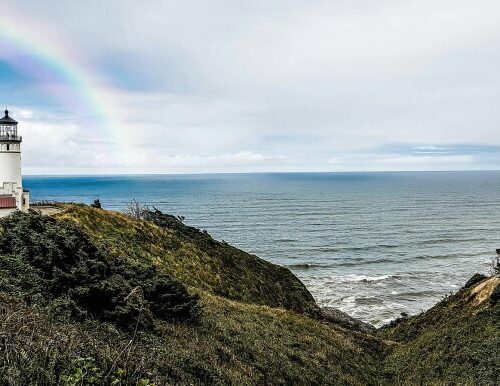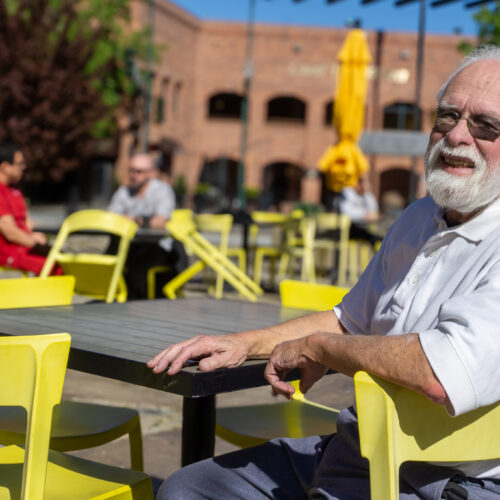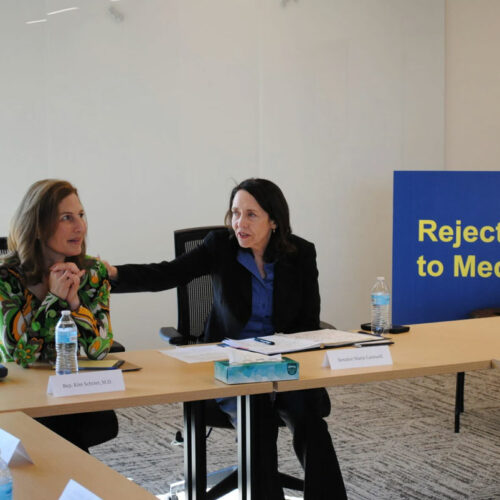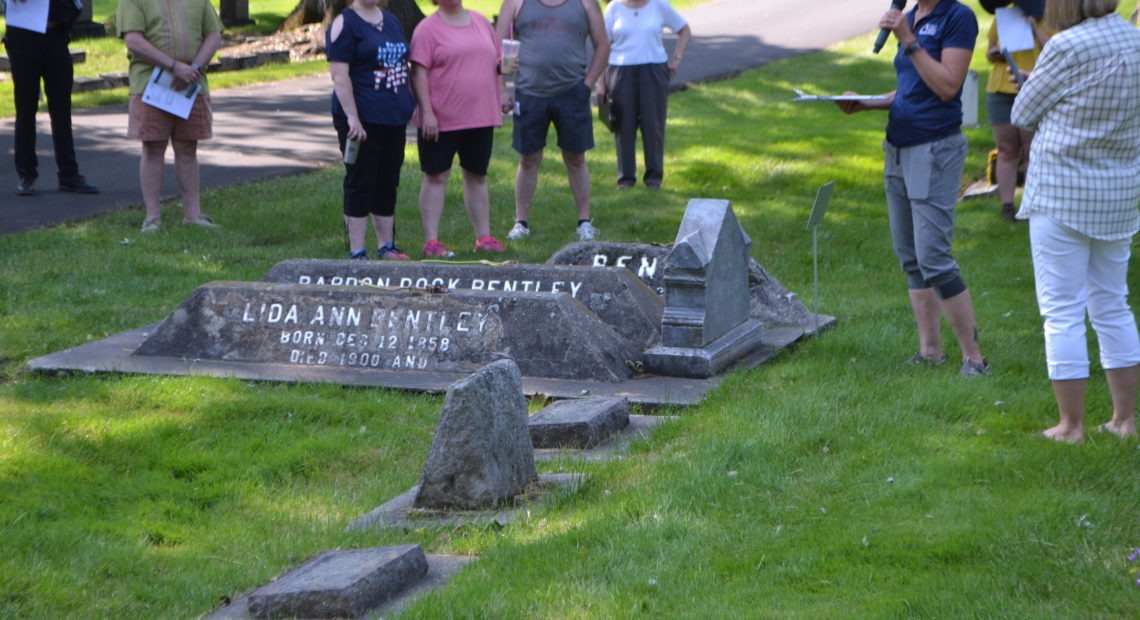
Grave Stories: Touring Walla Walla’s Mountain View Cemetery
READ ON
Fallen soldiers, outlaws, bankers, a madame, and maybe even a couple of witches all reside in one place now. It isn’t the set up for a bad bar joke, though.
Mountain View Cemetery in Walla Walla is the earthly home to these and other deceased figures.
RELATED: Roslyn’s Historic Cemetery Connects Immigrant Past To Present
Joanna Lanning hopes you’ll come by and meet them. On June 1, 2019, about 100 people did just that. Lanning, in her fifth year working at the cemetery — and her 25th year as an employee of the city of Walla Walla — saw the history waiting to be discovered in the 80-acre cemetery. She had to share it with as many people as possible.

Sherrilyn Jacobson, left center, and Joanna Lanning, led a tour of Walla Walla’s Mountain View Cemetery Saturday, June 1. The post-Memorial Day tour focused on the many veterans buried in the cemetery as well as local history. CREDIT: T.J. Tranchell/NWPB
“The more you look, the more you open your eyes when you aren’t too busy,” Lanning said of working at the cemetery.
While not the first self-guided tours of Mountain View Cemetery, the current tours, which Lanning started in 2018, highlight the depth of history and normalize death and grieving. Her efforts led to new signage and a walking tour that the curious can do on their own, as well as materials about the symbols used on headstones.
Tracing the history of symbols helped alleviate one rumor: There are no witches buried in Mountain View, just someone with a sense of humor and bad timing. According to Lanning, Pardon Bentley was the sextan (primary caretaker of the cemetery) in the late 1800s. He and his wife, Lida, lost a child young and later separated. Pardon had a humorous and cantankerous relationship with a mason who made headstones. A large concrete slab and stones were made before Pardon died and two blank sections were set in the primary marker. The blank areas were to have a morbidly funny saying engraved into them.

Around 100 people attended the June 1 tour of Mountain View Cemetery in Walla Walla. CREDIT: T.J. Tranchell/NWPB
After Pardon died, the mason didn’t finish the job, leaving parts of the Bentley’s markers — including final death dates — blank. That gave the stonemaker the last laugh and unwittingly created a town legend. Lida lived beyond her estranged husband, and while her name is on the extravagant marker, she has her own headstone a few feet away under which she lies.
Among the symbols on the Bentley’s stone is a hand pointing down, which Lanning said led some to believe God was pointing souls to Hell.
“It’s actually God reaching down to bring them to Heaven,” Lanning said.
As the tour progresses, the Bentleys are overshadowed by other characters from Walla Walla’s history.
“Ferd” J. Patterson
Another interesting tale is of Ferdinand “Ferd” J. Patterson. According to Lanning, he was a “self-proclaimed Confederate,” who was shot in a barber’s chair. The lawman who shot him escaped from jail, and Patterson’s grave was paid for by a girlfriend Patterson once “accidentally” scalped. The barber whose chair Patterson died in is buried less than 20 yards away.
“Dutch Jo” Wolf And Eva Baker
Then there’s the madame Josephine “Dutch Jo” Wolf. The madame’s grave, topped with a large cross, isn’t the only plot she owned in Mountain View. She also bought another plot for “her girls” as Lanning says in another area of the cemetery. Wolf was well-known for her philanthropic efforts, too. She funded the firefighter’s memorial in the cemetery, which has a replica in downtown Walla Walla.

Joanna Lanning has spurred the effort to place signs at markers of interest in Walla Walla’s Mountain View Cemetery. The markers facilitate a self-guided walking tour of the cemetery. CREDIT: T.J. Tranchell/NWPB
And the earliest resident of the cemetery is Eva Baker, who at just 12 days old, was the first to be buried in the there, six years before it was officially open. The infant, part of the family that established a bank and other businesses in Walla Walla, was also the first to be buried in a part of the cemetery known as Baker Circle.
Lanning, along with Sherrylin Jacobson, helped focus the June tour on the 2,000 documented (and perhaps nearly 3,100) veterans buried in the cemetery. With so many stories the tour could have gone on longer.

Sherrilyn Jacobson, a 20-year U.S. military veteran oversees the cemetery at Ft. Walla Walla. She joined Joanna Lanning for the post-Memorial Day tour of Mountain View Cemetery to discuss the abundance of veterans buried there, including many from the Civil War. CREDIT: T.J. Tranchell/NWPB
“We’re only using 60 of the 80 acres,” Lanning said. “The other 20 acres might have been used as a pauper’s field (a portion used to bury those who could not afford individual burial), so we’re never going to use it.”
Lanning, who has taught a death and dying class at Walla Walla University, says the cemetery is a place to celebrate life as much as it is a place to remember those who have died.
“The cemetery is part of (Walla Walla) Parks and Recreation for a reason,” Lanning said. She added that people walk and ride bikes on the paths and there is plenty of wildlife if you keep your eyes open.
Exploring the history of the cemetery and getting to share it keeps Lanning going during her days on the job. Whether it is tracking down the grave of a Civil War veteran or learning new things about the symbols surrounding her, she is reminded that the cemetery is not a dead place.
“When you can keep learning, you’re alive,” Lanning said.
Mountain View Cemetery is located at 2120 S. 2nd Avenue, Walla Walla, Washington. More information on walking tours.
Related Stories:

Echoes Of Today’s Unrest Run Through ‘The Cold Millions,’ Set In Spokane’s Rough Past
Jess Walter’s new novel an adventure tale based on actual events in the early days of the last century’s labor movement — which was much wilder and bloodier than most people remember.

A Yakama Woman’s Promise To Her Elders Sheds Light On A Forgotten Northwest War
Emily Washines was 18 years old when she was crowned Miss National Congress of American Indians. Yakama tribal councilmembers and elders sung a warrior song for her and then extracted a promise. Tribal leaders had something in mind. They wanted Washines to remember a message about a little-known war that wracked the Northwest in the 1850s.
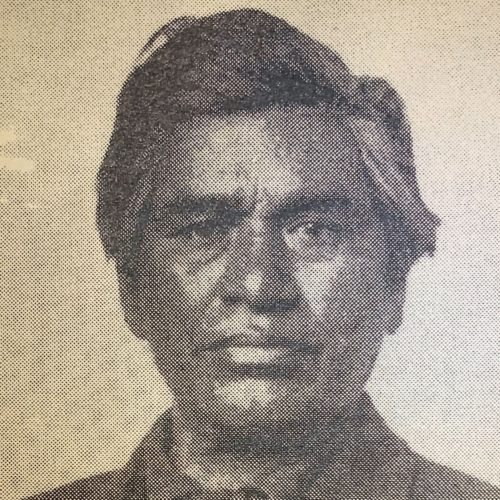
Louis Mann: A Yakama Nation Interpreter, Educator, Advocate Is Heard Again After 100 Years
The Treaty of 1855 created the Yakama Nation reservation as we know it today. In the decades after, the Yakama, Washington state, and the United States were trying to figure out their new relationship. At the turn of the century, Louis Mann was in the middle of it all, working as an interpreter for the tribe. Now, audio recordings of Mann’s strong voice have resurfaced.



